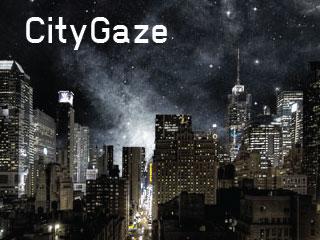CityGaze
Anaid Gomez Ortigoza
David Steele Overholt
CityGaze uses urban landmarks as stars in constellations.
http://citygaze.davidoverholt.com

Classes
Media Architecture,Urban Computing
Our cities have obstructed our ability to see the stars. CityGaze asks users to use landmarks in their own lives (such as parks, buildings, and crossroads) as stars and constellations to create a new way of viewing, navigating, and imagining their city.
Background
We hardly ever see the stars in New York.
Finding our way around the city usually relies on previous experience, places we know and an understanding of the streets and the geographic space. In urban areas, particularly New York landmarks, parks, monuments, buildings are everywhere. They give the city personality and tourist spots. Looking at a map, they crowd the streets. Finding shapes by connecting all this dots and giving them a story to tell and a connection to the city and the individual is the goal.
The objective is to define a narrative structure to make for a more memorable experience of the city. Rely on memory techniques that help the user get around with a sense of logic of the place. Think about maps and positioning systems available today and come up with a meaningful mythology for New York that can be associated to the space in this way.
Audience
People in New York, residents and visitors. Adults.
User Scenario
You walk through the Upper West Side, not entirely familiar with the area. A bluejacking message or perhaps a postcard directs you to a link on your mobile web browser to see a layer of Google Maps that has stars on it, connecting this place to others in the area. It also gives you access to more information about Colombus Circle (where you are right now), it's history and how it relates to the area though it offers other categories. It tells you this place is part of the stroller constellation that represents the Upper West Side, ths suburb of Manhattan in Manhattan and that you are located on the right wheel, and that the next point in the constellation is the Metropolitan Opera House. All of this information creates a connection between the user and the physical space and allows him to remember, the location of landmarks in relation to each other as well as give him on site information.
Implementation
It's got printed materials and a web platform. The user can find the content there on (through a mobile platform) and off site. It relies on cell phone triangulation for positioning and Google Maps.
Conclusion
Celestial navigation is very complex and deeply imaginative but really powerful.
Creating narratives for NYC is a big task! Looking to define a "mythology" that relates us in a more meaningful way to the space and it's history requires a delicate balance.
Defining the "important" landmarks is difficult.
There are too many levels of information in NY, let's make them available on site and create an experience that uses the city as it's scenario!
Background
We hardly ever see the stars in New York.
Finding our way around the city usually relies on previous experience, places we know and an understanding of the streets and the geographic space. In urban areas, particularly New York landmarks, parks, monuments, buildings are everywhere. They give the city personality and tourist spots. Looking at a map, they crowd the streets. Finding shapes by connecting all this dots and giving them a story to tell and a connection to the city and the individual is the goal.
The objective is to define a narrative structure to make for a more memorable experience of the city. Rely on memory techniques that help the user get around with a sense of logic of the place. Think about maps and positioning systems available today and come up with a meaningful mythology for New York that can be associated to the space in this way.
Audience
People in New York, residents and visitors. Adults.
User Scenario
You walk through the Upper West Side, not entirely familiar with the area. A bluejacking message or perhaps a postcard directs you to a link on your mobile web browser to see a layer of Google Maps that has stars on it, connecting this place to others in the area. It also gives you access to more information about Colombus Circle (where you are right now), it's history and how it relates to the area though it offers other categories. It tells you this place is part of the stroller constellation that represents the Upper West Side, ths suburb of Manhattan in Manhattan and that you are located on the right wheel, and that the next point in the constellation is the Metropolitan Opera House. All of this information creates a connection between the user and the physical space and allows him to remember, the location of landmarks in relation to each other as well as give him on site information.
Implementation
It's got printed materials and a web platform. The user can find the content there on (through a mobile platform) and off site. It relies on cell phone triangulation for positioning and Google Maps.
Conclusion
Celestial navigation is very complex and deeply imaginative but really powerful.
Creating narratives for NYC is a big task! Looking to define a "mythology" that relates us in a more meaningful way to the space and it's history requires a delicate balance.
Defining the "important" landmarks is difficult.
There are too many levels of information in NY, let's make them available on site and create an experience that uses the city as it's scenario!